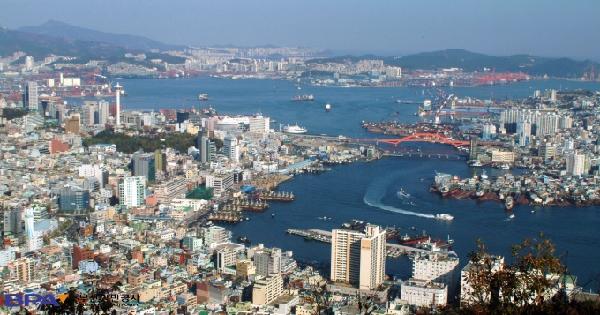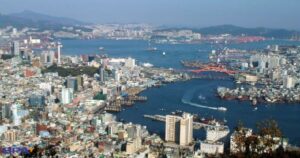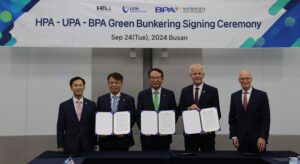South Korea’s Ministry of Oceans and Fisheries (MOF) has unveiled a whopping 14 trillion KRW (circa $9.78 billion) investment plan to upgrade the Port of Busan by 2045 aiming to achieve
South Korea’s Ministry of Oceans and Fisheries (MOF) has unveiled a whopping 14 trillion KRW (circa $9.78 billion) investment plan to upgrade the Port of Busan by 2045 aiming to achieve the world’s largest container handling capacity and establish the port as a “leading” logistics hub in the region.

As disclosed by the Ministry on December 11, the decision to upgrade the Busan Port is a response to the mounting challenges that have restructured the maritime industry worldwide.
Geopolitical uncertainties, like the intensifying U.S.-China rivalry and Middle Eastern tensions, have created a ripple effect on international trade flows, MOF said, while global supply chain disruptions—exacerbated by the COVID-19 pandemic and climate-related events—have continued to strain logistics networks.
This has prompted many shipping companies, as well as governments and regulatory bodies, to respond to the challenges by reorganizing their alliances, opting for vessels of more considerable sizes as well as more sustainable fleets, expanding terminals, building ‘smart’ ports, and introducing environmental rules and regulations as the maritime industry sails toward net zero.
Among these, the South Korean ministry has underscored that numerous Chinese and Singaporean ports have taken the ‘lead’, in a way.One noteworthy example would be the partnership struck between the Maritime and Port Authority Singapore (Singapore MPA) and China’s Shandong Provincial Transport Department.
Namely, in October this year, the two parties penned an agreement to create a new green and digital shipping corridor (GDSC), aimed at fostering sustainable and technologically advanced maritime trade between Singapore and China’s Bohai and Yellow Sea regions.
Core strategies to boost Busan Port’s (sustainable) development
As South Korea’s primary gateway for maritime trade, Busan Port has been described as a central place for ensuring the stability of the country’s export-import logistics and one of the ‘epicenters’ of the country’s climate neutrality ambitions.
According to MOF, currently, the port handles 76.8% of the nation’s container cargo, giving it ‘strategic importance’ not just domestically but also as a transshipment hub in Northeast Asia.
Related Article
-
 Posted: over 2 years ago
Posted: over 2 years agoBusan Port outlines roadmap to carbon neutrality by 2050
Categories:- Transition
Posted: over 2 years ago
The Ministry stressed, however, that, due to the rise of protectionism in major countries, without proactive investments and capacity expansions, Busan risks losing its competitive edge as it strives to attract global shipping lines.
Despite its ‘strategic’ position and its significance, the Busan Port has experienced certain operational challenges, such as inefficiencies in berth management and the occurrence of inter-terminal transshipments (ITT) due to fragmented operations.
Seeking to remedy this reality, the MOF elaborated that the recent investment plan will have the aim of transforming Busan into a “megaport” capable of tackling these hurdles head-on.
As understood, among the core strategies under the investment’s umbrella is the funding that will go toward constructing the Jinhae New Port—located near Changwon, which is around 39 kilometers from the city of Busan—where there are plans to build 66 berths.
This is expected to create container storage areas that are approximately 1.5 times larger than the existing terminals, meaning they could berth 30,000 TEU ships (beyond the current 24,000 TEU).
As per the Ministry, this matches the exact berth number in Singapore’s Tuas Port, which was officially opened at the beginning of September 2022 and is targetted for full completion during the 2040s, according to the Singapore MPA.
The first phase of the Jinhae New Port, consisting of nine births, will reportedly be handled by a single operator. It is expected that the integration of this port with the Busan Port could establish South Korea’s ‘largest’ operational system capable of handling 6 million TEUs.
Shedding more light on having a single operator fully handle these volumes, MOF clarified that this could lead to better berth management and minimized transshipment at other ports. On the other hand, if the existing terminal operators of the new port consolidate, incentives worth up to KRW 10 billion are set to be provided to offset facility integration costs and rent.
The Ministry has also unveiled plans to expand the overseas logistics centers from the current five locations—in Barcelona, Spain, Rotterdam, the Netherlands, Los Angeles, the U.S. and two in Java, Indonesia—to eight by 2027 and 16 by 2032.
These centers are envisioned to provide priority access and logistics consulting for South Korean small-sized enterprises. What is more, equity stakes and operational rights in ‘major’ global port terminals, alongside the creation of a KRW 1 trillion international logistics fund to provide a helping hand to ventures expanding overseas.
Furthering these efforts, the South Korean government also noted that a 362-hectare hinterland will be made near Busan Port. MOF elaborated that such land reserves, combined with institutional support, could spark more investments and thus revitalize the local economy.
It could also bolster Busan Port’s capacity for independent cargo generation, while the planned integration with the Gadeokdo New Airport—the construction of which is projected to commence in June 2025—could be one more step up the ladder for the port’s ambitions to become a ‘vital’ multimodal logistics hub across the land, sea and air.
On the green end of the story, by 2050, Busan Port reportedly aims to derive 25% of its energy from renewable sources such as solar, fuel cells and offshore wind powerby 2032 and 100% by 2050.
Infrastructure for green ship fuels like methanol and ammonia are also set to be established, together with carbon-neutral cargo-handling equipment, which is hoped to improve air quality and ‘advance’ carbon neutrality goals.
A notable example of such endeavors happened in late September when Germany’s Hamburg Port Authority (HPA) signed a joint declaration of intent with the Busan Port Authority (BPA) and Ulsan Port Authority (UPA) to work together on the decarbonization of maritime transport in the future by expanding the use of environmentally friendly marine fuels.
The tripartite agreement also covered a goal of jointly promoting standardization in the use and bunkering of low-carbon ship fuels and work on digitalization processes.
Related Article
-
 Posted: 2 months ago
Posted: 2 months ago
In order to support intelligent port systems, the government’s branch has set aside KRW 500 billion smart port fund, too.
Among other green initiatives supported by South Korea’s Ministry of Ocean and Fisheries is also the 2023 pledge to provide official development assistance for marine energy programs in the Pacific Ocean, including the support for ocean thermal energy conversion (OTEC) scheme in the Marshall Islands.
This MOF-backed aid initiative, worth $5.2 million, was reported to be planned for completion by the end of 2026, according to the United Nations.
As for the Busan Port itself, in mid-October this year, the port passed a ‘big’ milestone by hosting its first-ever LNG-powered cruise ship – the 2023-built Silver Nova owned by Monaco-based Silversea Cruises.
Content Original Link:
" target="_blank">

























































